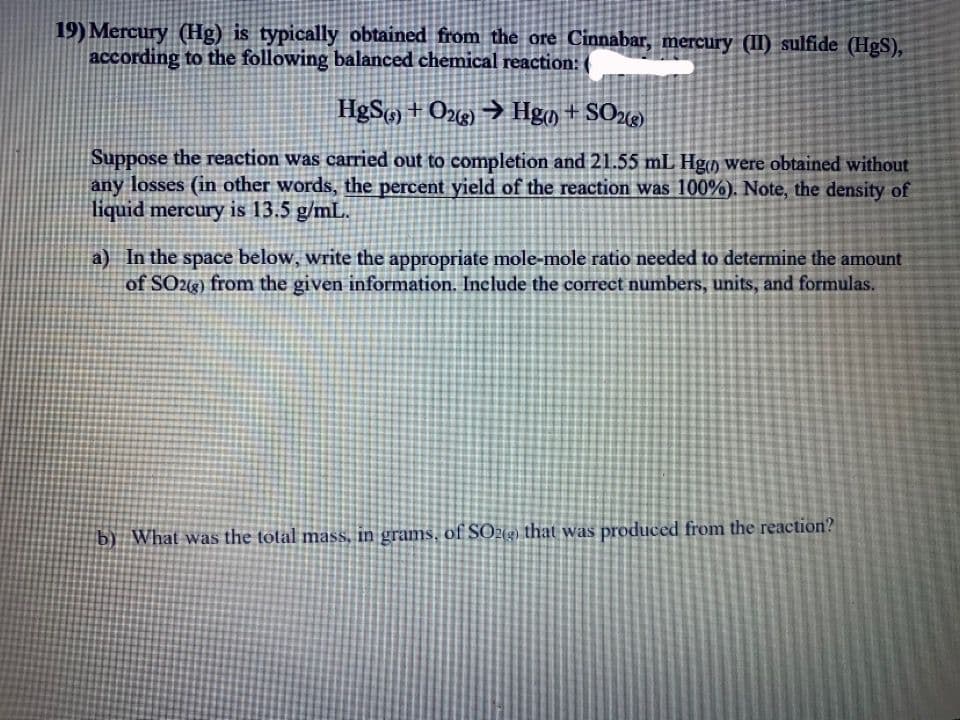19) Mercury (Hg) is typically obtained from the ore Cinnabar, mercury (II) sulfide (HgS), according to the following balanced chemical reaction: ( HgSo + O2g) → Hgŋ + SOe Suppose the reaction was carried out to completion and 21.55 mL Hgọ were obtained without any losses (in other words, the percent yield of the reaction was 100%). Note, the density of liquid mercury is 13.5 g/mL. a) In the space below, write the appropriate mole-mole ratio needed to determine the amount of SO2(s) from the given information. Include the correct numbers, units, and formulas. b) What was the total mass, in grams, of SO29) that was produced from the reaction?
19) Mercury (Hg) is typically obtained from the ore Cinnabar, mercury (II) sulfide (HgS), according to the following balanced chemical reaction: ( HgSo + O2g) → Hgŋ + SOe Suppose the reaction was carried out to completion and 21.55 mL Hgọ were obtained without any losses (in other words, the percent yield of the reaction was 100%). Note, the density of liquid mercury is 13.5 g/mL. a) In the space below, write the appropriate mole-mole ratio needed to determine the amount of SO2(s) from the given information. Include the correct numbers, units, and formulas. b) What was the total mass, in grams, of SO29) that was produced from the reaction?
Chemistry for Engineering Students
4th Edition
ISBN:9781337398909
Author:Lawrence S. Brown, Tom Holme
Publisher:Lawrence S. Brown, Tom Holme
Chapter4: Stoichiometry
Section: Chapter Questions
Problem 4.105PAE
Related questions
Question
Help solve

Transcribed Image Text:19) Mercury (Hg) is typically obtained from the ore Cinnabar, mercury (II) sulfide (HgS),
according to the following balanced chemical reaction: (
HgS) + O2g) → Hgn + SO
Suppose the reaction was carried out to completion and 21.55 mL Hg() were obtained without
any losses (in other words, the percent yield of the reaction was 100%). Note, the density of
liquid mercury is 13.5 g/mL.
a) In the space below, write the appropriate mole-mole ratio needed to determine the amount
of SO2(3) from the given information. Include the correct numbers, units, and formulas.
b) What was the total mass, in grams, of SO29 that was produced from the reaction?
Expert Solution
This question has been solved!
Explore an expertly crafted, step-by-step solution for a thorough understanding of key concepts.
Step by step
Solved in 5 steps

Knowledge Booster
Learn more about
Need a deep-dive on the concept behind this application? Look no further. Learn more about this topic, chemistry and related others by exploring similar questions and additional content below.Recommended textbooks for you

Chemistry for Engineering Students
Chemistry
ISBN:
9781337398909
Author:
Lawrence S. Brown, Tom Holme
Publisher:
Cengage Learning

Principles of Modern Chemistry
Chemistry
ISBN:
9781305079113
Author:
David W. Oxtoby, H. Pat Gillis, Laurie J. Butler
Publisher:
Cengage Learning

Introductory Chemistry: A Foundation
Chemistry
ISBN:
9781337399425
Author:
Steven S. Zumdahl, Donald J. DeCoste
Publisher:
Cengage Learning

Chemistry for Engineering Students
Chemistry
ISBN:
9781337398909
Author:
Lawrence S. Brown, Tom Holme
Publisher:
Cengage Learning

Principles of Modern Chemistry
Chemistry
ISBN:
9781305079113
Author:
David W. Oxtoby, H. Pat Gillis, Laurie J. Butler
Publisher:
Cengage Learning

Introductory Chemistry: A Foundation
Chemistry
ISBN:
9781337399425
Author:
Steven S. Zumdahl, Donald J. DeCoste
Publisher:
Cengage Learning

Chemistry: The Molecular Science
Chemistry
ISBN:
9781285199047
Author:
John W. Moore, Conrad L. Stanitski
Publisher:
Cengage Learning

Chemistry for Engineering Students
Chemistry
ISBN:
9781285199023
Author:
Lawrence S. Brown, Tom Holme
Publisher:
Cengage Learning

Chemistry: Principles and Practice
Chemistry
ISBN:
9780534420123
Author:
Daniel L. Reger, Scott R. Goode, David W. Ball, Edward Mercer
Publisher:
Cengage Learning